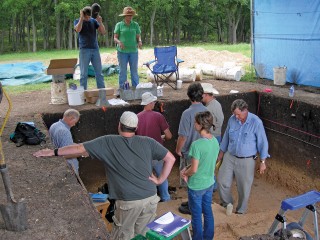
Courtesy Photo
By Daniel C. Houston
Reporter
Two Baylor professors helped uncover a secret that now has the scientific community abuzz: Central Texas was home to what are now the oldest known human inhabitants on the American continents.
The findings of professors of geology Dr. Steven Driese, chair of the geology department, Dr. Lee Nordt, dean of the College of Arts and Sciences, and their collaborators at Texas A&M University seem to indicate that human civilization lived 50 miles southwest of present-day Waco about 15,500 years ago.
“The site that our colleagues began excavating is called the Debra Friedkin site, and it contains artifacts that precede in age by about 2,500 years the oldest previously identified artifacts associated with this Clovis culture,” Driese said. “Baylor geology was invited to partner in this because there was concern on the part of the archaeologists that we had to demonstrate that the artifacts had not been mixed or put out of order by soil processes.”
Clovis culture is a prehistoric Paleo-Indian culture that archeologists have determined to be about 13,500 years ago.
The dating process at the Salado excavation site used three distinct methods: analyzing the shaping of the tools themselves; finding the age of the soil by measuring when the quartz in the soil was last exposed to ultraviolet radiation from the sun; and geologically analyzing the soil, in which the two Baylor professors were primarily involved.
Driese and Nordt were brought in to assess the soil formation processes, the chemical and microscopic nature of the soil materials and whether cracks in the soil could have preserved relatively young artifacts at a greater depth in the archaeological site, Driese said. The results of their work validated the project and will end up rewriting history books.
“What our guys did was proved that what they were actually looking at was undisturbed by the soil mixing,” said Matt Pene, assistant director for media communications, “and they proved that it was undisturbed and that the artifacts were actually in the same place that they were discarded 15,500 years ago.”
Driese described Dr. Michael Waters, the project manager and professor of anthropology at A&M, as being “very conservative and very careful” to double-check all the findings not once, but twice before publishing the results of the project, which is why he requested the assistance of Driese and Nordt.
“I think the project leader realized early on that there were going to be some issues about the site that would be vulnerable to attack by the skeptics,” Driese said. “There may still be — probably fewer, now — skeptics about whether humans were in the Americas before the time of the Clovis culture.”
The professors’ work on this project was published in the April issue of the journal Science, which Driese believes will help Baylor establish a more positive reputation as a research institution. The article has 13 co-authors, including Driese and Nordt.
“I think when Dr. Nordt and I got involved in this some three or four years ago,” Driese said, “we both knew that this site had the potential to be groundbreaking and publishable in Science, which is probably the most prestigious [scientific] journal in the United States.”
Driese said his contributions to data analysis and interpretation were essential to the project’s success.
“We fused our interest and involvement and our interpretation so we were constantly cross-checking our interpretations and went to the field together on a number of occasions,” Driese said. “He contributed equally to the project.”






